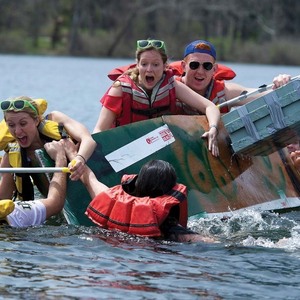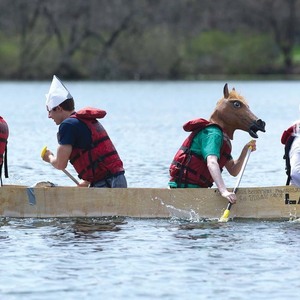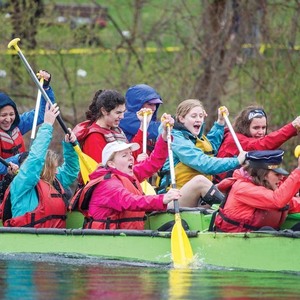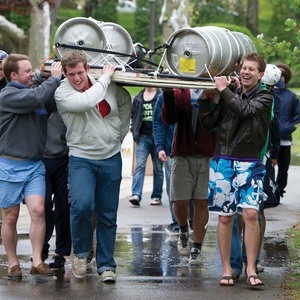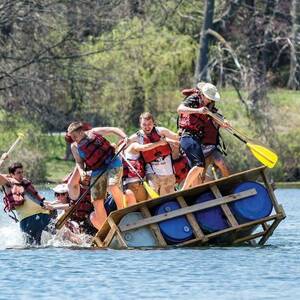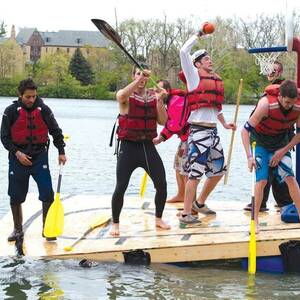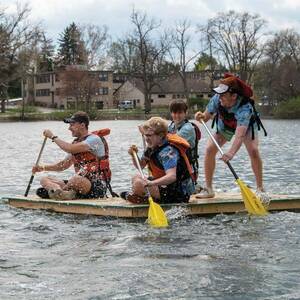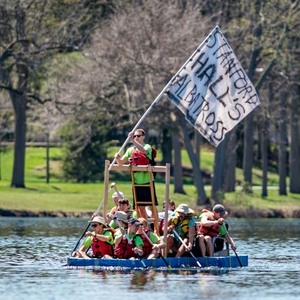Twenty-nine words dropped with a thud into the email inboxes of Fisher Hall residents as many were wakening on an otherwise regular Tuesday last October. Rector Joey Quinones ’18,
’20M.Ed., ’21M.S., wrote:
Fishermen,
There will be a mandatory town hall tonight at 8 p.m. in the Chapel regarding news involving the hall. Please do your best to be in attendance.
YGR [Ya Gotta Regatta],
Joey
Whispers about the dorm’s future grew to a din. Residents could read between the lines: This was the beginning of the end for Fisher Hall.
Donated by Sally Fisher of Detroit in memory of her husband Fred, Fisher Hall opened as a men’s residence hall in 1952. Students have long lamented the quality of the hall’s architecture and amenities. Each year, the murmurs increased until they became part of Notre Dame’s cultural lexicon.
That night, the lights were dim in the Fisher chapel as some 180 men filed in. This was no weeknight Mass. If anything, the mood felt closer to a funeral. Nervous chatter filled the air.
Rev. Gerry Olinger, CSC, ’01, ’04J.D., ’09M.Div., vice president for student affairs, began with a smile: “Good evening, friends, and thank you for being here. . . .”
He went on to inform the residents, myself included, that Fisher Hall and its neighbor, Pangborn Hall, would be demolished at year’s end. He got a surprisingly positive reception — but only because he announced that the Fisher community will be preserved, moving to an empty dorm for two years while a new hall is built. Then he said the new hall will have a different name, and the air went out of the room. “Fisher” will be no more.
Quinones reassured residents with words of wisdom about community and change. “Boats are safer in their port,” he said. “But that’s not the aim of boats.”
When Olinger and Quinones took questions, there was a moment of awkward silence, of collective wondering: Who will ask it first? A single hand went up.
“What’s going to happen to the regatta?”
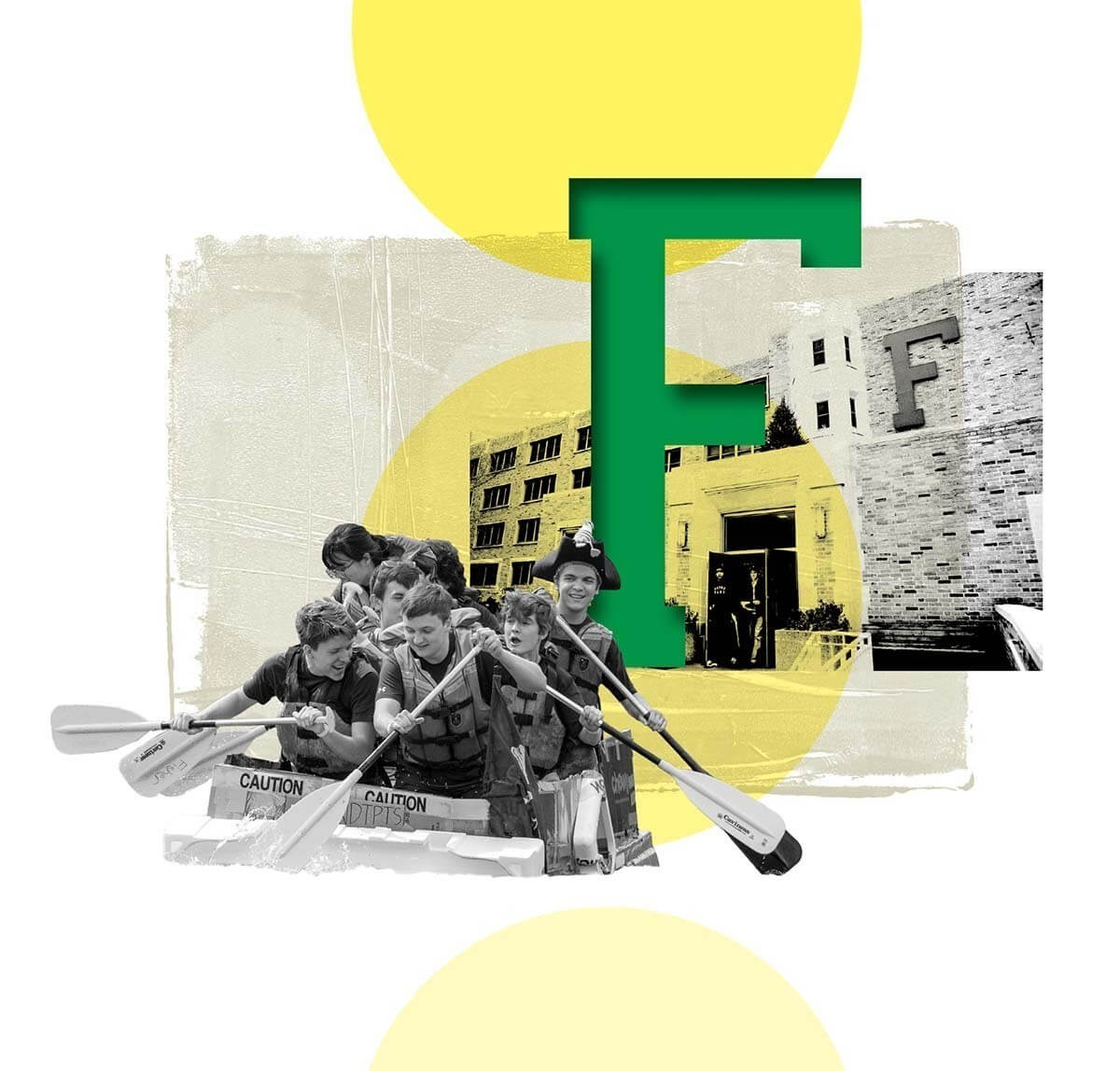
My first experience with the Fisher Regatta was April 15, 2023. An excited freshman, I was filled with anticipation for what, I had been told, was the greatest collegiate event known to humankind. I arrived early that morning on the shores of Saint Mary’s Lake.
By the spring of my freshman year, I had taken to sitting down by the lake a few nights each week to watch some of the most beautiful sunsets I had ever seen. Facing west, I would absorb the fiery colors on the horizon as they created watercolor paintings on the placid surface. I grew accustomed to the heron flying overhead, ducks quacking in conversation, and the deep blue of the sky as sunlight faded away. Night after night, peace prevailed.
Not so on regatta day, when grilled burgers and hot dogs, a dunk tank and merchandise sales created a carnival-like atmosphere. The color (and smell) of the water in the tank prompted one thought: Cholera. That water is going to give someone cholera.
At an early hour, Fishermen were already setting up: the tent raised over the grill, the burgers unpacked, T-shirts being placed out for sale.
I wandered away from the dunk tank and concession stand and stopped at the tent closest to the lake — the livestream table. This was to be my task for the day, ensuring the broadcast of our funky boat race to the event’s many eager fans.
The technological setup was . . . cutting-edge. We had an iPhone camera (my own) and a microphone to capture the announcers. A slew of wires connected the two to a computer (someone else’s) perched on a rickety music stand with its screen facing the water so that its camera could film the finish line. Occasionally, the computer shut down, losing our livestream. Whenever this happened, a runner had to find the owner to log us back in.
A rotation of Fisher Hall freshmen with mohawks worked as announcers. By no means a requirement, the hairstyles are a staple of regatta week; Fisher seniors serve as barbers, crafting not mohawks so much as domes shaved bald with hair pasted on top, all to raise money for a good cause. For about the past decade, proceeds from regatta entry fees, T-shirt sales, concessions and online donations have supported St. Adalbert Catholic School in South Bend, where Fisher residents regularly volunteer.
I was not sporting a mohawk. As much as I believe in the regatta’s charitable mission, I figured I could get my mother to donate more for me to keep my hair. Utilitarian, sure, but I thought this would do the most good.
The sky that April day was a crystalline blue, dotted with the kind of cumulus clouds that carry the optimism of spring. Giant sycamores on the northern side of the lake were just sprouting their leaves. Spectators milled about the thick green lawn in the background of our camera shot. We went on-air at 1 p.m.
“The Keenan Revue, A Carroll Christmas . . . all great events. But none quite encapsulate the Notre Dame spirit like the granddaddy of ’em all: the Fisher Regatta.”
That was the mohawks talking.
“I’m Joseph ‘Money’ Tunney, Fisher name Moderate-to-Severe Rheumatoid Arthritis.”
“I’m Adam Akan, Fisher name Borgan Stanley. Pleasure to be here with you all today.”
“I’m Andrew Rosello, Fisher name Bud Knight. It is a joy to be out here for the 25th annual Fisher Regatta, the sun is shining, the water is shining . . .”
“. . . and the boats are racing!” Borgan Stanley finishes.
“The format of the regatta is, of course, a boat race. Four boats at a time race in heats around a buoy and back again,” says Moderate-to-Severe Rheumatoid Arthritis as the video cuts in and out. “The obvious, obvious elephant in the room is that not all the boats are necessarily seaworthy. . . .”
Judging from the array of watercraft being carried to the launch spot, I thought my friend Money was understating things. I caught sight of what looked like a long laundry basket with pool noodles taped to its edges.
The rules have always bent the regatta toward ridiculousness. First published in a 1988 story in The Observer, event regulations stipulate that vessels must be no more than 16 feet long or 6 feet wide and designed to carry between four and eight students. Over the years, aspects of the rules have been adapted or downright disregarded, but one rule remains unchanged and has had the most influence on the competition’s character: “No parts of a conventional boat may be used.”
The first regatta, in 1987, was small. Fifteen boats entered, and the unpredictable spring weather dampened the festivities. Rain canceled the planned picnic and live band. But a seed of absurdity had been planted, and it took root quickly.
Two years later, entries included The St. Edward’s Hall Firebrewed Pic-a-nic Warrior, a party barge cut from three giant Styrofoam blocks. The barge featured a cooler and a grill on which sailors cooked hot dogs. They didn’t win, nor did they try. As one of the crew put it: “You can’t enjoy your food if you’re sweating from rowing.”
St. Ed’s led early in pushing boundaries, outdoing themselves in 1991 by constructing a two-story houseboat complete with Astroturf, sofas, even a doghouse boat.
Bigger has not always been the goal. Brother Edward Luther, CSC, a former Fisher rector, remembers a vessel built entirely of tree limbs. “It just fell apart,” he told The Observer in 1993. “They went about two feet.”
That happens a lot. One hears tales of a “graveyard” of boats at the bottom of Saint Mary’s Lake.
Pangborn’s 1987 entry was buoyed by several repurposed kegs — a common building material to this day — their contents, one assumes, having been emptied in the days before the race.
Another popular gimmick is the floating basketball court, first attempted by Sorin College at the 2000 regatta. Most of these — like Fisher’s 2012 El Flota Part Deux — end up among the wreckage.
Not all the boats are so flimsy. Fisher Hall often goes all out for its signature event. In 2001, for instance, the Green Wave launched The Jolly Piggott. Modeled on a Spanish galleon, the craft weighed 400 pounds and was chained up outside the hall for weeks before the race. It set sail with an official capacity of 12 and an unofficial capacity of “as many as we can take . . . safely!”
While The Jolly Piggott may be an excellent example of regatta spirit — and what can happen when engineering students have too much time on their hands — as often as not, an air mattress will do.
“We probably spent about 15 minutes on this,” air-mattress crew member Michael Isaacs ’12 told The Observer in 2011. “Five minutes driving to Goodwill, five minutes driving back and five minutes blowing up the air mattress.”
In 1991, Dillon Hall residents brought scores of water balloons on board for pelting their competitors. The Observer quoted a spectator: “It’s not a race, it’s a war!”
In 2002, Carroll won its third consecutive men’s division title despite sabotage by Fishermen the night before. Another group of Fisher residents helped the Carroll crew dry out their sunken boat just in time for it to win the race.
The irony was lost on no one the year a Naval ROTC group entered a boat . . . and it sank. “About 90 to 95 percent of all boats make it across,” regatta co-commissioner Joe Caruso ’05 told The Observer. “That’s why we couldn’t believe that of all the boats, the Navy boat would sink.”
No antics or ironies stick out from my memories of Regatta Day 2023. That event was about champions. In the women’s division, a team of engineers led by Anne Myler ’24 won handily. Then, in the open division, they finished second to a team of Siegfried Hall sophomores, Ayden Ellis and Emanuel Telles Chaves.
“I have wanted to build a boat for several years now,” Ellis told The Observer. “The Fisher Regatta was one of the first things I saw when I was looking at colleges. And so I started building a boat the summer before I went to Notre Dame.”
The year prior, when he was a freshman, Ellis’ sleek wooden craft had capsized almost immediately. Joey Quinones, the rector, recalls the scene: “I’m sure they were fuming that the air mattresses were making it across the finish line, and they’re just like, waist deep in lake water.”
In 2023, Ellis’ team returned with a vengeance. They built a new boat, practiced for three days and blew the competition, well, out of the water. The name of their craft? The Redemption.
All these stories have fed regatta lore, which, if you believe this letter to the Observer editor, long predates Fisher Hall, and even the University itself: “Contrary to popular belief, the regatta did not begin at Notre Dame,” Fisher resident Sean Wolohan ’14, ’16M.Ed., wrote as a freshman. “Our founder Fred Fisher’s great-great-grandfather, Christopher Columbus, won the Fisher Regatta in 1492 with a boat called the Santa Maria. We all know how that turned out.
“Even before that, God and Noah Fisher teamed up to construct the Ark for the deadliest Fisher Regatta in history. Many boats have come and gone since then, and now is your chance to enter the annals of history next to legendary regatta champions like Ferdinand Magellan, Captain Morgan, Leif Ericson, The Skipper and Captain Crunch.”
The regatta does not lack a penny in entertainment value. It’s easy to forget that hilarity was never the original goal.
‘Fresh fish’ are welcomed with a baptism ceremony. Fishermen assemble outside, and the returning students stand on the steps facing the freshmen. In lines organized by floor, each freshman drops to one knee as a cup of water is poured over his head by his resident assistant. They are told, ‘Rise, and receive your oar.’
Campus tour guides leading visitors along South Quad identify important buildings like South Dining Hall and the Rockne Memorial Gymnasium. Nestled between the two, Fisher and neighboring Pangborn mostly go unmentioned and — if the guides are doing their jobs correctly — unseen.
The so-called “gold coast dorms” — Lyons, Howard, Morrissey — stand in regal splendor with views of the lake. Across the quad, Fisher is easy to miss. During the spring, summer and early fall, trees shield its façade. Come November, the building becomes visible as the leaves fall. It has no ornate carvings, no sloping, slate rooftops. Instead, blocks of four windows apiece stare like lonely eyes across the quad. The dominant color is army tan, the pockmarked brick creating an array of khaki shades. It’s like an oversized cardboard box.
Additional shapes protrude from the main structure. Here, it’s a one-story box with double doors off the front. There, a taller rectangle with narrow windows off the side. Permanent black stains below the roofline and windowsills evoke eyebags after years of restless nights. The lone touch of exterior vibrancy comes from the giant green F suspended above the main entrance.
Walking inside does no more to impress. Through the doors, four stairs lead up to a long hallway. To the left of the stairs, a glass door opens into a sitting room with an eclectic mix of faux-leather chairs and worn couches. The spartan decor includes portraits of benefactors Fred and Sally Fisher, hanging side by side to the right of a bathroom door.
The dorm’s crown — and maybe only — jewel is its chapel. Elsewhere, order was cast off long ago. Every resident has a tale about asbestos, black mold, cockroaches, mice and smelly water. Fishermen across the generations swap them like war stories — no one has it tougher than us. The joke goes that impoverished nations send aid to Fisher Hall, not the other way around.
Conditions were much the same in 1986 when Jay Farraher ’90 was assigned to Fisher Hall. He quickly discovered the prevalent mood: No one wanted to live there. “Thirty-five years ago, there were dorms that were on campus — Morrissey is a good example, Keenan Hall is a good example — [where] people just wanted to be. Fisher, from what I understood coming in, didn’t have that level of camaraderie. It was a place where people lived for a year or two and then went elsewhere.”
The tone changed that year. After eight years in Morrissey, Brother Ed Luther became Fisher’s rector. “My goal was to certainly get the friendship going there,” the 96-year-old Luther says today. With his encouragement, Farraher, John Conmy ’89 and their dormmates began to forge a hall culture.
“Notre Dame is nothing but tradition, right?” says Farraher. “And so, for us, establishing ourselves and creating the epicenter of something was what the regatta reflected. . . . It just kind of popped in my head one day that maybe we could do a homemade boat race.”
What happened next is legend. Stories in The Observer and Scholastic offer the image of a young freshman Farraher, pensively looking across the gleaming waters of Saint Mary’s Lake when the epiphany struck.
That’s nonsense, but Farraher did take evening runs around the lake with a friend. “I think it was kind of being in that environment — like, hey, we could do something here,” he says.
He took the idea to Luther, who was enthusiastic about establishing a dorm tradition. But the rector did have to ask just one question: “I said, ‘What in the hell is a regatta?’”
In the end, the rector signed off. As means of building Fisher camaraderie, the race was ideal, requiring buy-in not just from participants but committee members and volunteers for race day.
“There were a lot of people who decided they wanted to make Fisher Hall their four-year home. They wanted to develop the relationship,” Farraher says. “It wasn’t like a bus stop where they were just going to be for a couple of hours and then move on.”
From 15 boats at the first regatta in 1987, the event grew to 30 entries representing all dorms in 1991 and reached as many as 45 entrants in 2015. Fisher adopted its nickname, the Green Wave, from the event, and soon created its best-known physical identifier — the giant green F, roughly one-and-a-half stories tall, that hangs between the third and fourth floors, suspended from the roof by chains. A floodlight on the chapel roof illuminates it through the night.
New traditions have sprung up. Each year, “fresh fish” are welcomed with a baptism ceremony. Fishermen assemble outside, and the returning students stand on the steps facing the freshmen. In lines organized by floor, each freshman drops to one knee as a cup of water is poured over his head by his resident assistant. They are told, “Rise, and receive your oar,” and are handed a full length, wooden canoe paddle with a vibrant green F painted on the blade.
Later that week, freshmen receive a new name — not, one hopes, anything like “Moderate-to-Severe Rheumatoid Arthritis” — and learn the hall’s cheer, the Husky. In all, freshmen are introduced to a culture that strives to live the hall motto: “All are welcome in this place.”
The dorm’s physical structure, decrepit as it may be, has played a critical part in facilitating the environment. “There aren’t section lounges,” says Quinones. “There aren’t really floor lounges. There’s the basement, the basement that can house everybody. Between that, our chapel, in all the quads, that’s where you meet people. I think because those are our options, we have a culture of knowing everybody.”

The regatta has had its challenges. In 2009, the event struggled to raise sponsorship funds due to the financial crisis. Boat-building materials were expensive, but the regatta persevered.
When it returned from a one-year, pandemic-imposed hiatus in 2021, 40 boats entered and the race raised $21,000 for St. Adalbert, nearly doubling the previous record. Last year, the proceeds topped $20,000 again.
This spring, Fisher will hold its 37th regatta — or the 12th anniversary of the 25th Annual Fisher Regatta, as the joke goes. For commissioner Nick Biad, a junior from Las Cruces, New Mexico, the effort that goes into preparation pales in comparison to the rewards. “The regatta is the most innocent, pure and genuine way that Fisher combines as a community, connects with each other and works toward a common goal,” he says.
The event may be the blueprint for the way forward. Change is imminent in the Fisher community. The building that has forged a collective spirit among residents will be torn down. Fisher will no longer be its name. But the people whose lives have been changed by both will remain — and will remain together.
After a two-year layover in Zahm Hall, the community will move to a new, larger building. What about the traditions? What about the F? The oars?
What about the regatta?
“I think things like the regatta remind us who we are,” Quinones says. “Like service, a little bit of absurdity, that uniqueness that we really appreciate about ourselves.”
I walk out the front door, down the flagstone steps and across the South Quad grass toward Saint Mary’s Lake. I descend the stairs between Morrissey and Lyons, cross Holy Cross Drive and reach the water’s edge. I walk along the path toward the east end, seeking my sunset view.
I’ve made this walk many times during my short Notre Dame career. When things are good, I want to spend time by the lake. In difficult times, I need it. I tell myself: Go down to the water.
This evening, like most, the lake is placid. It reflects the trees, the sky and the setting sun. This lake, I think, is a reflecting surface in more ways than one.
Tonight I’m thinking about my dorm community. Seeking ourselves in the face of change is a scary prospect. I have a feeling the men of Fisher Hall will know what to do — especially come April. The walk’s not far. Go down to the water.
Ryan Murphy is a sophomore from Concord, New Hampshire. He is an American studies major and proud resident of Fisher Hall.
